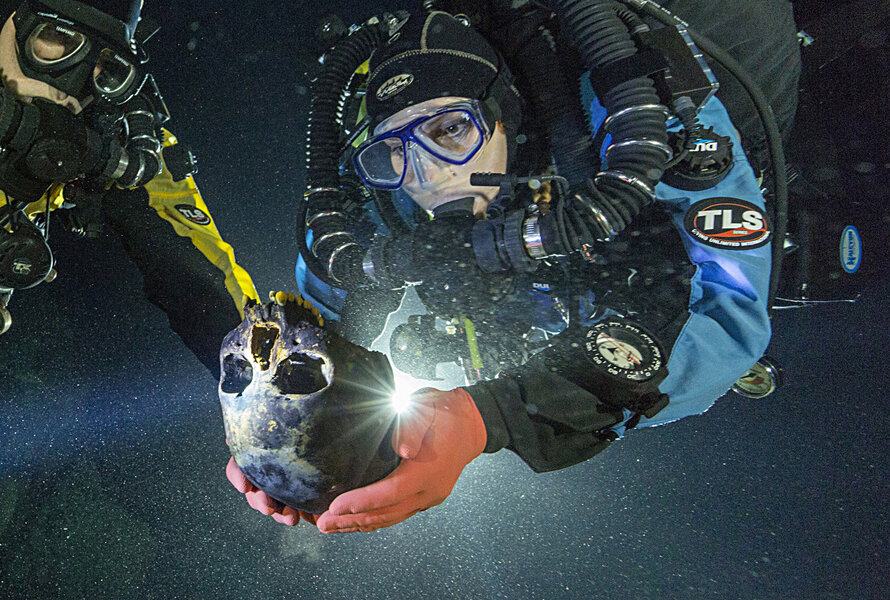Where did native Americans come from? 'Naya' skeleton paints detailed picture.
Loading...
One day about 12,000 years ago on Mexico's Yucatán Peninsula, a small 15-year-old girl with a narrow face, wide-set eyes, a broad nose, and a high forehead, entered a cave. No one knows who she was or what brought her there, but in those dry days of looming glaciers and low sea levels, it's possible she had gone looking for water.
What happened next is more certain: at the far end of the cave she fell 200 feet to the bottom of a deep, lightless, bell-shaped chamber, where she landed in a shallow pool of water and perished.
When glaciers melted and sea levels rose 10,000 years ago, that chamber filled up with water. In 2007, a group of Mexican and Venezuelan divers discovered the girl's well-preserved skeleton, which has become the most definitive evidence to date of native Americans' origins.
"As our eyes got accustomed to the environment, we started to notice large animal bones. The first one we saw was a large femur," said one of the divers, Alberto Nava, in a press conference. "All of a sudden Alex pointed to a human skull, lying on a ledge."
The girl's intact skull was surrounded by the rest of her bones and those of at least 26 other large mammals, including sabertooth cats, ground sloths, and elephantlike animals known as gomphotheres, all of whom at different moments in prehistory had tumbled into the same pit. The divers named the girl Naya, which is the Greek word for "water nymph."
Naya is the first complete Paleoindian skeleton among all the known remains of the people who first entered and populated the Americas. Remains have surfaced of fewer than 50 people who lived more than 10,000 years ago, and most of those are fragmentary. Few have intact skulls, and none, until now, have a complete set of teeth.
Against that patchy fossil background, Naya's distinctive craniofacial features and complete set of teeth give a picture of her origins whose completeness is unprecedented: her people came from Siberia and were the ancestors of modern native Americans, despite bearing little resemblance to them. One of Naya's molars yielded a segment of DNA, known as subhaplogroup D1, which originated in Asia and persists today in 10.5 percent of living native Americans, and 29 percent of indigenous Chileans and Argentines.
"This suggests that HN5/48 [Naya's specimen number] descended from the population that carried the D1 lineage to South America," says the study, which announced Naya's provenance in today's issue of Science. "Subhaplogroup D1 is derived from an Asian lineage but occurs only in the Americas, having probably developed in Beringia after divergence from other Asian populations."
Beringia is the name of the wide land bridge that once connected modern Siberia and Alaska, where migrants from Asia may have spent as many as 10 glacial millenniums, before fanning out and populating the Americas.
This is not the first time that DNA evidence has linked modern native Americans to ancient Beringians; in the past two years, genetic evidence gathered from an infant skull (named "Anzick") in Montana and from fossilized feces in Oregon have strengthened the widely accepted Beringia Theory of Native American origins.
But skepticism about that theory has persisted due to a mysterious disconnect: neither the faces nor the tooth patterns of native Americans resemble those of Paleoamericans. Naya's long, narrow cranium and small face, so unlike the distinctive flared cheekbones and broad faces of modern native Americans, is a perfect example.
In fact, while modern native Americans' faces and dental patterns bear close resemblance to modern people in Korea and Japan, reports the paper, nearly all Paleoamericans "are morphologically most similar to modern peoples of Africa, Australia, and the southern Pacific Rim."
But why would that be? How can two separate modern populations – East Asians and Native Americans – have so many traits in common, if their common ancestors, who produced Naya, looked so different?
As a way to explain this incongruence, some have proposed that native Americans' ancestors came from across the Atlantic, rather than over the Bering Land Bridge. But Naya's combination of Beringian DNA with unfamiliar features may put this idea, known as the Solutrean hypothesis, to rest for good.
"In light of this finding, the differences in craniofacial form between Native Americans and their Paleoamerican predecessors are best explained as evolutionary changes that postdate the divergence of Beringians from their Siberian ancestors," states the report.
So, native Americans very likely have Siberian origins. But this finding does not rule out the possibility of separate migrations into the Americas, including from Europe. "I strongly suspect and see evidence of multiple migrations over time," said James Chatters, the study's lead author. "We're saying Beringia is the source of Naya, Anzick, and also modern native Americans' background."
Determining Naya's age required a massive collaboration of universities and research groups. Initial efforts to extract enough bone or tooth collagen for carbon-14 dating were unsuccessful. But bushy calcite crystals that had formed on the bones of Naya and a nearby gomphothere when the cave was still dry, suggest they both tumbled into the cave before it flooded some 10,000 years ago.
Those crystals, known as florets, eventually dated the bones back to a minimum of 12,000 years ago, after scientists analyzed the extent to which quantities of two isotopes present, uranium-234 and thorium-240, had stabilized in relation to each other. Meanwhile, divers managed to scrape enamel off one of Naya's molars, whose radioactive carbon-14 levels point to a maximum age of 13,000 years old, two universities determined independently.
Thus, Naya lived between 12,000 and 13,000 years ago, during the Pleistsocene epoch's last glacial era, a period when we Homo sapiens wandered onto every continent but Antarctica, and the other human species who had kept us company for millenniums, probably died out for good.
The extraordinary unfolding of Naya's story seems to resonate with people, said Yemane Asmerom, a University of New Mexico geochemist who co-authored the new study. "I believe in the end, just like the story of Lucy, and our rovers on Mars, Naya's story touches on our deep human connection through space and time."








